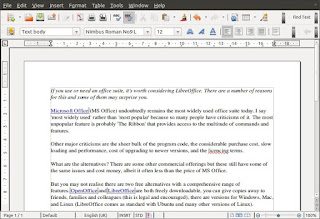If you use or need an office suite, it's worth considering LibreOffice. There are a number of reasons for this and some of them may surprise you.
Microsoft Office (MS Office) undoubtedly remains the most widely used office suite today. I say 'most widely used' rather than 'most popular' because so many people have criticisms of it. The most unpopular feature is probably 'The Ribbon' that provides access to the multitude of commands and features.
Other major criticisms are the sheer bulk of the program code, the considerable purchase cost, slow loading and performance, cost of upgrading to newer versions, and the licencing terms.
What are the alternatives? There are some other commercial offerings but these still have some of the same issues and do cost money, albeit it often less than the price of MS Office.
But you may not realise there are two free alternatives with a comprehensive range of features. OpenOffice and LibreOffice are both freely downloadable, you can give copies away to friends, families and colleagues (this is legal and encouraged), there are versions for Windows, Mac, and Linux (LibreOffice comes as standard with Ubuntu and many other versions of Linux).
OpenOffice and LibreOffice have a common history but LibreOffice is beginning to look like the front runner. Check out Google's list of review articles on LibreOffice.
I strongly urge you to give LibreOffice a try. It's free, so what have you got to lose? It contains everything you need - word processor, spreadsheet, business presentation, graphics, maths editor, and database. All are built to professional standards, can load and save in a range of file types (including MS Office formats), can save PDFs, are regularly updated and upgrades are, of course, free. If you need more information, take a peek at the manuals and user guides (you might like to start with the introduction).
Showing posts with label spreadsheet. Show all posts
Showing posts with label spreadsheet. Show all posts
05 October 2011
03 November 2010
TECHNOLOGY - The Cool Farm Tool
The Cool Farm Tool is a spreadsheet that allows farmers, growers and organisations interested in crop production to easily model greenhouse gas emissions and how they might be affected by changing production methods.
 The tool was originally developed for Unilever by a research team at the University of Aberdeen and is now being used on an increasing scale by individual farmers, companies buying agricultural and horticultural produce, cross company groups, researchers, governments, and inter-governmental agencies.
The tool was originally developed for Unilever by a research team at the University of Aberdeen and is now being used on an increasing scale by individual farmers, companies buying agricultural and horticultural produce, cross company groups, researchers, governments, and inter-governmental agencies.
The spreadsheet is published with an open source licence so it can be used, modified, and republished by anyone. It's accessible by ordinary farmers around the world and is easy to use without scientific expertise. The tool can be used to explore the effects of adjusting the methods of production to help minimise emissions.
An IPCC report in 2007, Mitigation of Climate Change provided global information, but Unilever knew they needed specific, farm or field level data if they were to make a difference. They commissioned the Cool Farm Tool as a means of obtaining this data. Much to their credit, Unilever and the University of Aberdeen decided to make the tool available for anyone to use or adapt.
There is more detail on Unilever's Growing for the Future website and in an article published by Ecosystem Marketplace.
I think this tool can really make a difference. Indeed, it must already have made a difference and will continue to do so. Well done to all concerned, especially Unilever and the University of Aberdeen. The planet needs more effort of this sort.
 The tool was originally developed for Unilever by a research team at the University of Aberdeen and is now being used on an increasing scale by individual farmers, companies buying agricultural and horticultural produce, cross company groups, researchers, governments, and inter-governmental agencies.
The tool was originally developed for Unilever by a research team at the University of Aberdeen and is now being used on an increasing scale by individual farmers, companies buying agricultural and horticultural produce, cross company groups, researchers, governments, and inter-governmental agencies.The spreadsheet is published with an open source licence so it can be used, modified, and republished by anyone. It's accessible by ordinary farmers around the world and is easy to use without scientific expertise. The tool can be used to explore the effects of adjusting the methods of production to help minimise emissions.
An IPCC report in 2007, Mitigation of Climate Change provided global information, but Unilever knew they needed specific, farm or field level data if they were to make a difference. They commissioned the Cool Farm Tool as a means of obtaining this data. Much to their credit, Unilever and the University of Aberdeen decided to make the tool available for anyone to use or adapt.
There is more detail on Unilever's Growing for the Future website and in an article published by Ecosystem Marketplace.
I think this tool can really make a difference. Indeed, it must already have made a difference and will continue to do so. Well done to all concerned, especially Unilever and the University of Aberdeen. The planet needs more effort of this sort.
Labels:
carbon,
carbon dioxide,
CO2,
emissions,
farm,
farmer,
farming,
global warming,
SciTech,
spreadsheet,
technology,
Unilever
Subscribe to:
Comments (Atom)
Copyright
© 2002-2022, Chris J Jefferies
This work is licensed under a Creative Commons Attribution-ShareAlike 3.0 Unported License. A link to the relevant article on this site is sufficient attribution. If you print the material please include the URL. Thanks! Click through photos for larger versions. Images from Wikimedia Commons will then display the original copyright information.


